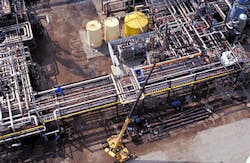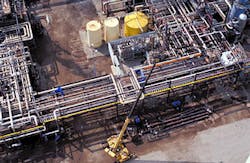TransCanada PipeLines Ltd. Pres. and CEO Harold N. Kvisle plans to make his firm the top gas pipeline and power generation company in the Northern Tier of North America.
Kvisle defines Northern Tier as anywhere north of a line drawn between San Francisco and New York.
He said that the Calgary-based TCPL is already there on the pipeline side with a network of more than 23,600 miles of pipe linking western Canada gas supplies with central Canada and the US. "We're already the number one pipeline company in the Northern Tier. Several US companies have significant assets in New York state, New England, Pennsylvania, and other places. But I don't think anybody in total would have as much pipeline or gas transport infrastructure as we do," Kvisle said.
Power expansion eyed
But, he said, the company has a long way to go on the power generation side, which now accounts for 20% of its business.
"The growth challenge for us is on the power side, where we are, frankly, a nobody in Northern Tier power today in a relative sense. The power business is so huge that we could grow our business tenfold and still not be the largest power company in the Northern Tier."
The company has tripled its power generation capacity in the last 21/2 years, including a number of large-scale projects in Alberta.
Kvisle said TCPL is actively looking for growth opportunities, and the company has "the healthiest balance sheet" in years. He said TCPL will be a substantially larger company 5 years from now, and it will not necessarily be confined to the Northern Tier. Potential for growth would come through project investment and acquisitions. Kvisle said the collapse of Enron Corp. is one situation that is worth examining.
"So many companies with their credit ratings under pressure will either be looking to sell assets to restore the balance sheet or perhaps looking for a corporate merger partner," Kvisle said.
"We think both of those open up opportunities for TransCanada. These are not necessarily opportunities we are going to do, but we will be focused on them and keeping our eyes open."
New Alberta gas lines
On the pipeline side, Kvisle said there is more than enough pipeline capacity now from Alberta to end markets, although the company has responded to a request from shippers with a proposal to develop more pipeline capacity to California.
"We see relatively little need in the next couple of years for long-haul capacity out of Alberta. What is always required, though, is new capacity to accommodate new gas coming on within Alberta," Kvisle said.
"As an industry, we bring on 3 bcfd of new gas every year just to offset decline. A lot of that new gas comes on from locations that are different from the old places."
The TCPL executive said his company has captured the lion's share of new gas coming from the hot Ladyfern play in northeastern British Columbia that is producing more than 500 MMcfd. And he fully intends to compete aggressively to pipe gas from that area. But he said there would be a lot more new gas coming out of Alberta than from British Columbia, just because it's a much bigger playing field.
Arctic gas
The biggest new playing field down the road may be the pipeline infrastructure required to bring arctic gas from Alaska's North Slope and Canada's Mackenzie Delta to southern markets (see special report beginning on p. 54, and story, this page).
TCPL, along with Foothills Pipe Lines Ltd., Westcoast Energy Inc., and six US companies, will make a proposal within a few weeks to Alaska gas producers for a pipeline following the Alaska Highway and running from Prudhoe Bay to connections in northern Alberta. Foothills, a joint venture of TCPL and Westcoast, already holds regulatory permits for a pipeline.
Kvisle said the proposal would be for a 42-in. or 48-in. line, with an initial capacity of about 2.5 bcfd and a price tag in the region of $8 billion. The cost of the line would be about half that of several alternatives examined by the Alaska producers, which, so far, have been rejected as uneconomic.
The gas would move through TCPL's Nova pipeline system to Empress, Alta., where liquids will be stripped before the gas is shipped to the US Midwest, Kvisle said.
The TCPL executive said the group's proposal is an incremental approach under which a commitment could be made to build a line and do the necessary engineering. Line capacity could then be expanded in stages as required by gas volume growth.
Kvisle estimated the cost of getting gas to Alberta at about $7 billion, plus an additional $1 billion to expand Alberta infrastructure. He said that if Alaska gas flows at an initial rate of 3 bcfd, however, and there were some decline in current Alberta production, existing pipelines would have surplus capacity to handle that gas.
An arctic pipeline would add further ties to the close energy integration that already exists between Canada and the US.
Kvisle noted that his company is the largest foreign shipper of natural gas to the US and that a continental energy policy is already in place. He said it is good for Canada to be "next door" to a huge and efficient energy market.
There already is coordination of all marketing and trading activities in Canada and the US. The Canadian and US energy economies are virtually integrated today-the one exception being electric power, Kvisle said.




